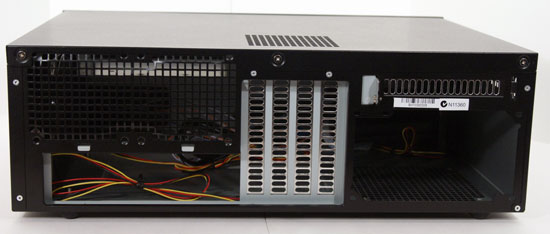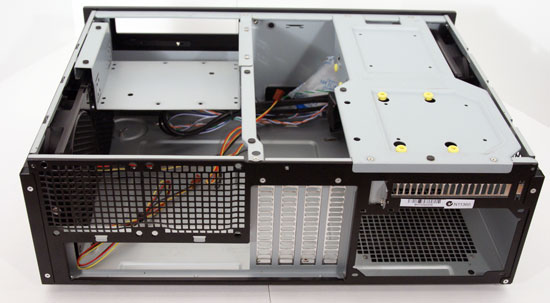SilverStone GD04 HTPC Case: Cool, Not Quiet
by Dustin Sklavos on December 25, 2010 12:00 AM EST- Posted in
- Cases/Cooling/PSUs
- HTPC
- SilverStone
- GD04
In and Around the GD04
A jaunt around the GD04 reveals a case that at least appears to be well-suited to its task. Most of the case is constructed with steel, but the front bezel is an attractive brushed aluminum and again, the case comes in silver or black depending on your taste. Personally, I think black goes with everything.
The front bezel is nice and spare, featuring the two USB ports, microphone and headphone jacks, the power and reset buttons, a power LED, the optical drive bay, and a SilverStone logo. There's a lot of negative space here and it's appreciated; the GD04 is going to look like it belongs in your home theater setup. When you look at the sides, you'll see the three 120mm intake fans: one on the left, two on the right. This is a positive pressure case, designed to bring in air through the sides then push it out through ventilation in the top and the back. There's also a vent on the bottom of the case, beneath where the power supply's intake fan would typically be, that stays unobstructed as a result of the reasonably tall standoffs.

The rear of the case features four expansion slots, the power supply bay, and a fifth expansion slot above it presumably meant for extra USB ports or an eSATA bracket. There's also ventilation above the port cluster that could support additional cooling, if you wanted to add a couple 80mm fans.
Assembly of the GD04 is done by removing the top panel and it's here that you first realize this is not going to be a tool-less affair: the panel is fastened with three Philips head screws, and these are only the first of many you'll need to use when you start putting your HTPC together in this case.

Once you get the top off, there are three additional pieces that can be and in fact need to be removed: the optical drive tray, the hard disk drive mount, and the crossbar. Removing all of these parts requires a grand total of ten screws, and you'll want to keep those in a safe place. That said, the inside of the GD04 is actually remarkably spacious, but people with long power supplies should be forewarned: something as long as the spare Corsair HX750 I had won't fit, as trying to install it results in it butting squarely up against the intake fan on the left side.
What's also worth noting is the low clearance beneath the optical drive tray. While stock coolers for most AMD processors will work fine, the Zalman CNPS7000 cooler I'm using in my build is only a few millimeters from scraping the bottom of the tray. You're going to want to use either the stock or a low profile cooler like a Scythe Shuriken (or, if you don't mind the scant clearance, the Zalman CNPS7000) when assembling a machine in the GD04.





















68 Comments
View All Comments
tno - Monday, December 27, 2010 - link
I'm gonna second your suggestions. There seems to be a lot of emotion flying around and I think that's great. I love that everyone here is so passionate about these things. And I've been in your spot in the past RobertR, and about Jarred (my apologies), who is clearly good enough, my complaints not withstanding, to warrant a supervisory position. So let's take all this in perspective.RobertR, they get it, you don't like the job they did. If you would like acknowledgment, then consider all the replies you've received all the acknowledgment you should reasonable need.
McKish, perhaps shooting Dustin an e-mail with a review of his review would help in future articles.
Jarred, Dustin might not have the hardware resources that AT does, but he does have the hivemind. Perhaps the next article should get a preview in the case section of the forum. Before I chose my case (P150) I scoured the old articles and soon after turned to the forums and found so much information that my choice was made easy and once bought all the information I needed to pick the right sound components for the case. That said, it's easy for a comment or paragraph to spark all sorts of reactions (see everything in these comments for proof) but once you've gotten through all the nonsense, there's often some good points to be made.
So keep on going Dustin. Your writing is great, and your methods will get there. For a look at good methods and iffy writing, see anything on silentpcreview.com that isn't written by Mike Chin. Find something between there methods and yours and you'll have it all together. And keep up the case reviews; to get you going, start posting on all the forums you can find, get involved in the online community that obsesses over this stuff, and get your name known by the community reps that control the equipment. My favorite part of your review, realistic components. And yes, they are realistic, most people putting together an HTPC just put together a quicky job that will do the work. They don't obsess over every single component to find the coolest running, quietest component possible. Indeed, most probably take spare parts they have lying around. SPCR's habit of using outdated overkill components with silent cooling components is above and beyond what any of us would roll. I would definitely recommend having on hand whatever the "BEST" component for the category your testing per AT. For instance the quieter ATI cards seem to be a favorite for HTPC's on AT, perhaps having one of those available would quiet the beasts.
Alright, that's my wall of text. Flame on!
tno
khaakon - Sunday, December 26, 2010 - link
Is it only me, or have I missed any comments about this case short depth? It is very few HTPC cases with this form factor and it really makes a difference when you're putting the box in place and fitting all the goddam cables ;)Anymore depth in the approach when testing wouldn't be amiss also, (environment and adaption) but nice try anyway - just no spliff.. I mean Cigar.. for Dustin.
juzz86 - Monday, December 27, 2010 - link
I would just like to say that it's been a while since I've seen a case review here, and I love them. Let's see a few more!marc1000 - Monday, December 27, 2010 - link
it's good to see a review of a case that works with positive air pressure.ignoring all the flames about noise, the temperature of components seemed pretty good. they show a big difference regarding slow/fast fan RPM, yet even on lowest speed it seems very cool to me. I would like to ask that positive air pressure is tested on other cases (it could be a quick test, just to compare with the default configuration, and done simply reversing any output fans to make then intake ones - except GPU/PSU of course).
thanks for the review,
combust3r - Monday, December 27, 2010 - link
I belive that Dustin mentioning possible collision with left 120mm fan and long PSU's is a valuable info for those who want to use this case as a gaming rig. I bought Grandia GD05 for my Sandy Bridge build and I've already ordered GTX 460 wich is relatively short comparing to many high end 10.5"/11" cards that this case supports. My Seasonic M12II 520W will fit with no problems at all but PSU's longer than 180mm will force you to replace 120mm with 80mm fan (left fan mounts are predrilled for 80mm fan). Airflow (as seen in the review) is very good and it's worthy to mention that graphic cards with external exhausts are preffered.Regarding db measurement, if this is standard procedure in noise testing in all anandtech case reviews then I'm fine with it. They must be comparable.
I really like your review Dustin, keep up the good work.
orenlevy - Monday, December 27, 2010 - link
there is a simple way to reach silence in those areas1 you need mobo with 2 or 3 headers that u can control threw software
planty of those mobo are there(u can Google it to find)
2 find the right fan configure mostly to make a side to side air flow in the case
normally you should covers the places where air can go in the other sides.
3 make rules in speedfan give minimum and maximum speeds of the fans.
discover what are the temperature u reading and start to make the logic
if CPU then fan n01 will ramp and so on
one fan normally on the hard drive so it will controlled also buy hard-drive temp
after a bit of experience today it takes me no more then 5 min.
the fans actually can rest in idle and small surfing playing music and in a bit of stress the fans gos around 600 rpm in full 1000 rpm then it is important choose the wright power supply
,the only thing u can hear
ClagMaster - Monday, December 27, 2010 - link
I am surprised no mention was made of the fans that came with the case. Who made the fans and what are their rated speed, air flow and noise.I never had a complaint about a Silverstone case. These are well made though a little on the pricey side.
I would have invested in three 120mm Synthe Fans with the same air flow instead of the fan controllers. Its ridiculous to have two fan controllers in a HTPC.
combust3r - Wednesday, December 29, 2010 - link
http://www.globefan.com/products_detail.php?Pid=23...These are the fans used.
The middle one in the chart, RL4ZS1202512LIW-3M 12V DC 0.26A
34dBA, 2K rpm...
ClagMaster - Wednesday, December 29, 2010 - link
Thank youClagMaster - Wednesday, December 29, 2010 - link
These fans are rated at 93 cfm each !!! And there are 3 of these !!!This is way, way too much for a home entertainment center.
I would have replaced these with Scythe SY1225SL12M 120mm "Slipstream" Case Fan
1200 RPM, 68 cfm, 24 dBA
And there would still be plenty of air flow
Again, thanks for answering my question.